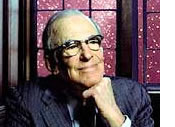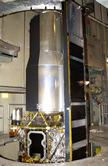| Lyman Spitzer, Jr. (1914-1997) |
|
 Lyman Spitzer was an American astrophysicist who laid the foundation for the study of the
interstellar medium, a then poorly understood yet dominant component of space comprising
all the stuff between the stars. He founded the Princeton University Plasma Physics Laboratory,
wrote several books that became the standard reference for the study of hot gas, and originated
the idea of flying a telescope in space. Without Spitzer's insight, guidance and determination,
the Hubble Space Telescope would not exist. Lyman Spitzer was an American astrophysicist who laid the foundation for the study of the
interstellar medium, a then poorly understood yet dominant component of space comprising
all the stuff between the stars. He founded the Princeton University Plasma Physics Laboratory,
wrote several books that became the standard reference for the study of hot gas, and originated
the idea of flying a telescope in space. Without Spitzer's insight, guidance and determination,
the Hubble Space Telescope would not exist.
Spitzer was just beginning his career, a young man in his 30s, when he published a short paper
in 1946 about astronomy from space. This was a bold idea; not even a rocket capsule had been placed
in orbit at this point, let alone a sophisticated instrument. Nearly all astronomy — aside from
cosmic ray experiments from high-altitude balloons — was done from the ground.
Yet a great debate sparked interest in non-optical, non-ground-based astronomy. A new theory
in Spitzer's day was that stars were powered by nuclear fusion. Calculations showed that our sun
could burn for billions of years this way. But more massive stars would burn for only a few hundred
million years. So, Spitzer theorized that stars were being created in the modern era, and that the
intergalactic medium, a dark and mysterious place, held the reservoir of matter to create new stars.
Scientists found evidence of this matter with large, ground-based optical telescopes. Yet the proof,
Spitzer knew, would be found in the ultraviolet observations of young, hot stars. The Earth�s atmosphere
blocks most ultraviolet radiation, so to observe these hot stars, scientists needed to send a UV detector
above at least most of the atmosphere.
Spitzer, an avid mountain climber, perhaps thought of space as the ultimate mountaintop. Even optical
observations, he argued, would be greatly enhanced by rising above the distortions caused by water and
gases in the atmosphere. During the 1960s, Spitzer convinced the astronomy community of the necessity of
a "large space telescope," called LST. By the 1970s, the community gave the LST high priority in a major
report, which led NASA to begin a Phase A study of a 3-meter telescope in 1973. More importantly, Spitzer
helped convince Congress to fund the project, which ultimately became the 2.4-meter Hubble Space Telescope.
All the while, Spitzer's career at Princeton University blossomed. The laboratory he founded with Martin Schwarzschild
in the late 1940s became the leading graduate program for theoretical astrophysics. Spitzer continued to
write seminal theoretical papers through the 1950s and 1960s. Sounding rockets were piercing the atmosphere
with X-ray and ultraviolet detectors, and a balloon carried an optical telescope above most of the atmosphere,
as Spitzer had hoped. The showpiece of Spitzer's own space astronomy work at Princeton was NASA's Copernicus
Orbiting Astronomical Observatory, launched in 1972. Spitzer was the principal investigator for this ultraviolet
telescope. Copernicus did indeed find evidence of hot, young stars in dense clouds that block optical light but
not all the ultraviolet light, and made many other key findings. The success of Copernicus helped secure Hubble's
funding as well as Spitzer's legacy.
Spitzer was born on June 26, 1914, in Toledo, Ohio. He studied physics at Yale University and was inspired
to take up astrophysics upon meeting Subrahmanyan Chandrasekhar (for whom the Chandra X-ray Observatory is named)
while on a fellowship at Cambridge University. He returned to the United States in 1936 to begin his graduate
studies at Princeton University, where he earned his Ph.D. in astrophysics in 1938. After a year as a postdoctoral
fellow at Harvard University, Spitzer joined the faculty of Yale University in 1939. During World War II he performed
underwater sound research, working with a team that led the development of sonar. He returned to Yale for a short
while but soon moved to Princeton University to be chairman of the astrophysical sciences department at the remarkably
young age of 33.
The rest of Spitzer's career was spent at Princeton, where he directed the astronomy department until 1979.
Still active in the 1990s, Spitzer was analyzing Hubble data and published several papers on interstellar clouds.
He was working on a new paper when he died on March 31, 1997.
 NASA does not name telescopes after people still living. But, as with his friend and colleague Chandra,
NASA named the fourth and final Great Observatory after him, the Spitzer Space Telescope. This infrared observatory
excels in the study of the intergalactic medium, the scientific discipline that Spitzer created. A slightly longer
biography that details other aspects of Spitzer's career is available at http://www.spitzer.caltech.edu/about/spitzer.shtml. NASA does not name telescopes after people still living. But, as with his friend and colleague Chandra,
NASA named the fourth and final Great Observatory after him, the Spitzer Space Telescope. This infrared observatory
excels in the study of the intergalactic medium, the scientific discipline that Spitzer created. A slightly longer
biography that details other aspects of Spitzer's career is available at http://www.spitzer.caltech.edu/about/spitzer.shtml. |